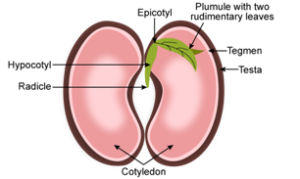Selina Concise Biology Class 9 ICSE Solutions The Flower
APlusTopper.com provides step by step solutions for Selina Concise ICSE Solutions for Class 9 Biology Chapter 4 The Flower. You can download the Selina Concise Biology ICSE Solutions for Class 9 with Free PDF download option. Selina Publishers Concise Biology for Class 9 ICSE Solutions all questions are solved and explained by expert teachers as per ICSE board guidelines.
Download Formulae Handbook For ICSE Class 9 and 10
ICSE SolutionsSelina ICSE Solutions
Selina ICSE Solutions for Class 9 Biology Chapter 4 The Flower
Exercise 1
Solution A.
- (d) large colourful bracts
- (d) It has all the four whorls.
- (c) Ovary
- (c) Ovule
- (d) Androecium and gynoecium
Solution B.1.
| Column A | Column B |
| (a) Polyadelphous | (i) Bombax |
| (b) Pollen grains | (ii) Pollen sac |
| (c) Free petals | (iii) Polypetalous |
| (d) Non-essential | (iv) Calyx, corolla |
| (e) Sweet fragrant fluid | (v) Nectar |
Solution C.1.
(a) Incomplete flower – If one or more sets of floral structures are missing, the flower is called incomplete flower. E.g. American elm.
(b) Staminate flower – A unisexual flower which contains only the stamens, i.e., male parts of a flower is called male or staminate flower. E.g. Eastern cottonwood.
(c) Pistillate flower – A flower which contains only the carpels, i.e., female parts of a flower is called female or pistillate flower. E.g. Date palm.
(d) Bisexual flower – A flower which contains both stamens and carpels is called bisexual or hermaphrodite flower. E.g. Hibiscus.
Solution C.2.
| Flower | Inflorescence |
| Flower is a specialized shoot in which the leaves are modified into floral structures. | Inflorescence is the mode of arrangement of flowers on the axis of the plant. |
(b) Petals and Petaloid sepals
| Petals | Petaloid sepals |
| Petals are non-essential parts of a flower which help in protection of reproductive parts and make the flower attractive for pollination. | Undifferentiated petals and sepals together form the perianth. When perianth is non-green, it is called a petaloid. |
Solution C.3.
(a) Placenta:
Location: Cushion or swollen region in the ovary
Function: Gives origin to ovules
(b) Thalamus:
Location: Tip of the flower stalk
Function: Bears all the parts of the flower
(c) Anther:
Location: Part of the stamen
Function: Produces male gametes or pollen grains
(d) Stigma:
Location: Terminal knob-like part
Function: Serves as the landing place for pollen grains during pollination
Solution C.4.
(a) The androecium of pea flower is diadelphous because the filaments of anther are united in two bundles. In case of pea, out of ten, nine stamens form a staminal tube while one is free.
(b) Ray florets of sunflower are neuters because both male and female reproductive organs are lacking or absent.
(c) Salvia sepals are petaloid because the three sepals are united and are red in colour like petals. Hence, they are undifferentiated from the petals.
(d) China rose stamens are epipetaloid because they arise from the base of the petals.
Solution D.1.
Types of androecium in flowers:
- Polyandrous: When the stamens of a flower are free, the condition is called polyandrous.
- Monadelphous: When the filaments of anthers in a flower are fused into one group, the condition is called monadelphous.
- Diadelphous: When the filaments of anthers in a flower are fused into two groups, the condition is called diadelphous.
- Polyadelphous: When the filaments of anthers in a flower are fused into more than two groups, the condition is called polyadelphous.
Solution D.2.
(a) China rose: Monadelphous
(b) Bombax: Polyadelphous
(c) Pea: Diadelphous
Solution E.1.
(a) The flower is of Sweet pea.
(b) Standard: Outermost petal which is large and broad
Wings: The two lateral petals are in the form of wings
Keel: Two wings enclose two inner petals which unite to form a keel
Solution E.2.
1: Anther; 2: Filament: 3: Ovule: 4: Placenta; 5: Stigma;
6: Style; 7: Ovary; 8: Petal; 9: Sepal; 10: Receptacle/Thalamus
Solution E.3.
(a) Figure A represents stamen. Stamens collectively form Androecium.
(b) Contents of the pollen sacs in B are male gametes.
(c) The contents of the pollen sacs would come out through agents like air, wind, insects leading to pollination in flowers.
Solution E.4.
When a flower arises in the axil of a leaf-like structure, this structure is known as bract. Because bracts are large and brightly coloured structures, they are often mistaken for petals. This helps to attract insects for pollination.
Solution E.5.
| Condition of androecium | Explanation | Example of flower |
| Monadelphous | Filaments of the anthers in a flower are fused into one group | Hibiscus |
| Diadelphous | Filaments of the anthers in a flower are fused into two groups | Pea |
| Polyadelphous | Filaments of the anthers in a flower are fused into more than two groups | Bombax |
More Resources for Selina Concise Class 9 ICSE Solutions
